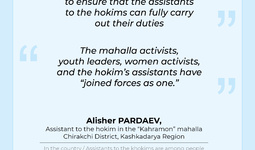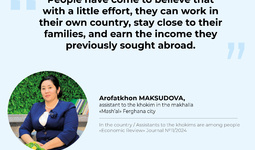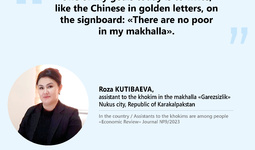— Please briefly tell us about your professional career and how you came to your current position. What skills help you perform your duties effectively?
— In 2022, our country introduced a new model of improving the system of economic management by establishing the position of Assistant to the khokim in every mahalla. This initiative, launched by our President, is significant because it aims to support entrepreneurship, further enhance mechanisms for income-generating employment, and reduce poverty. Before assuming this position, I worked as the First Deputy Head of the Finance Department in the Sardoba district. My professional background is in economics. Over the course of my career, I gained extensive experience working in the finance department as a specialist in the "Financing of Agriculture and Development of Household Plots" division and later as Head of the "Family Entrepreneurship Development" department. This experience has proven very useful in my current role. As an Assistant to the khokim, one must work with the population daily, inform people about the opportunities created by the government, and help lift them out of poverty by teaching them the basics of entrepreneurship and agriculture.
— Could you tell us about the location of your mahalla, the infrastructure there, and employment opportunities for the population?
— The “Kuyitosh” mahalla of Sardoba district in the Jizzakh region is located in the district center. Currently, there are two general education schools, two preschool educational institutions, and nine family-based kindergartens operating in our mahalla. The infrastructure of the mahalla meets modern standards. In particular, the population is fully supplied with natural gas and drinking water. The territory includes 24 kilometers of roads, of which 2,877 meters are unpaved, 15,143 meters are gravel, 1,320 meters are concrete, and 3,521 meters are asphalt.
— According to survey data, what were the priority tasks and key drivers of the mahalla’s development? What were the main findings of your research?
— The mahalla consists of 1,047 households, 1,351 families, and a total population of 5,520 people. The mahalla specializes in crop cultivation and livestock farming. Agricultural activity is carried out by 502 households, employing 1,152 people. Animal husbandry is practiced by 384 households, providing employment to 764 citizens.
— Please describe the results of your work in 2024 and your main areas of focus.
— The economic factor plays a major role in ensuring the welfare of the population. Over the course of 2024, 68 citizens in the “Kuyitosh” mahalla received loans totaling 1.3 billion sums, leading to the creation of 75 new jobs. To ensure sustainable sources of income for the population, 104 people were employed in permanent jobs, and 331 individuals registered as self-employed. Another 29 people engaged in individual employment, and 15 participated in paid public works. In addition, 59 citizens registered as dehkan farms, while three individuals received equipment and tools worth 25.51 million sums in subsidies from the “Fund for Promoting Entrepreneurship.” During 2024, 94 citizens were referred to training, 79 received vocational education, and 15 were trained in entrepreneurship. The activities of 23 enterprises and individual entrepreneurs were restored.
— What are the development priorities for the mahalla in 2025? What are your plans and what has already been achieved?
— In 2025, 1,460 individuals will be employed. Of these, 10 will be through the launch of large and regional investment projects, and 950 through entrepreneurship development. Permanent jobs will be provided for 358 people, 592 will be engaged in entrepreneurial activity, and 480 will be employed in permanent and seasonal agricultural work. In the construction sector, 19 new jobs will be created. A total of 40 microprojects (creating 80 jobs) will be implemented by the Assistant khokim in cooperation with commercial banks. Commercial banks will also organize two meetings with entrepreneurs and create seven permanent jobs. As a result of efforts to promote entrepreneurship, 212 citizens will become self-employed and 36 private enterprises will be established. As part of family entrepreneurship development programs, 2.8 billion sums in concessional loans will be allocated.
— Based on your experience, what are the main causes of poverty in the mahalla, and what is being done to address them?
— The main causes of poverty are the lack of permanent employment, insufficient education, and a lack of knowledge and skills in entrepreneurship. Research shows that most poor families in the mahalla include people with disabilities, pensioners, and women raising children. Furthermore, many individuals lack interest or understanding of business before launching their own ventures. Government reforms aimed at poverty reduction are based on the principle of “For the honor and dignity of every person.” Examples include subsidies, financial aid, and concessional loans for unemployed and vulnerable citizens. The free vocational training system for unemployed individuals in in-demand professions is a positive step toward increasing employment and, consequently, household income. As of January 1, 2025, there were 125 low-income families (509 members) in the mahalla, making up 9.5% of the population. By the end of the year, 253 members of 46 families will be lifted out of poverty. This includes 62 citizens employed in permanent jobs, 136 engaged in entrepreneurship, 12 who will receive agricultural land for lease, and 11 who will be employed after completing vocational training. An additional 32 people will be supported through other initiatives. As a result of these efforts, the poverty rate is expected to fall to 6.9% by the end of the year.
— What has been done to develop entrepreneurship during your time as Assistant to the khokim?
— When I began working at the “Kuyitosh” mahalla, there were 56 registered business entities. Today, we have increased that number to 238. This progress was largely guided by Presidential decrees supporting small business development. Our mahalla demonstrates the idea that a country with prosperous entrepreneurs becomes a prosperous country. I can confidently say that by 2025 our mahalla will be free of unemployment. The number of successful entrepreneurs is growing every day. We have also attracted job seekers from neighboring mahallas to work in businesses based in our mahalla.
— What efforts are being made to support returning labor migrants and encourage them to stay in the country?
— Significant efforts are underway in this area. In Sardoba district, 151 citizens returned from labor migration between January and December 2024. Of these, 134 received support. Specifically, 29 were employed in existing or newly created jobs, 18 received support to become self-employed, seven were assisted in starting businesses and obtaining loans, and three were referred to vocational training. Among those who returned, eight found work independently, six started their own businesses, and 17 returned abroad for work. Additionally, 63 individuals are currently engaged in informal employment.
— What recommendations can you offer to improve the effectiveness of Assistant Hokims in Uzbekistan?
— We have all the necessary conditions to carry out our duties effectively. However, I recommend that banks simplify the screening process for concessional loans aimed at business development. This would help establish many new enterprises, improve living standards, and boost tax revenues.
— What new goals and plans have you set for 2025?
— My main goal is to take the mahalla to a new level in the near future by solving existing problems and providing citizens with practical support.
Jamoliddin Turdimov, CERR
"Economic Review" Journal №5/2025





















leave a comment